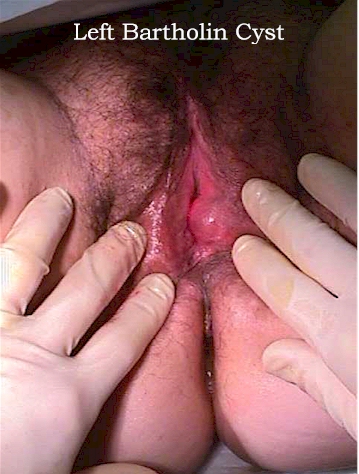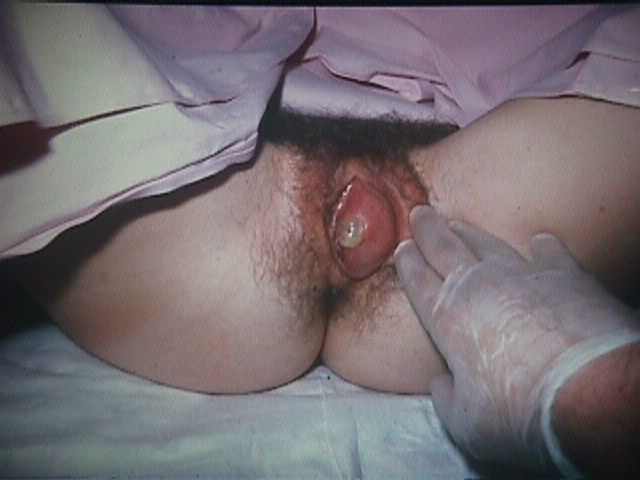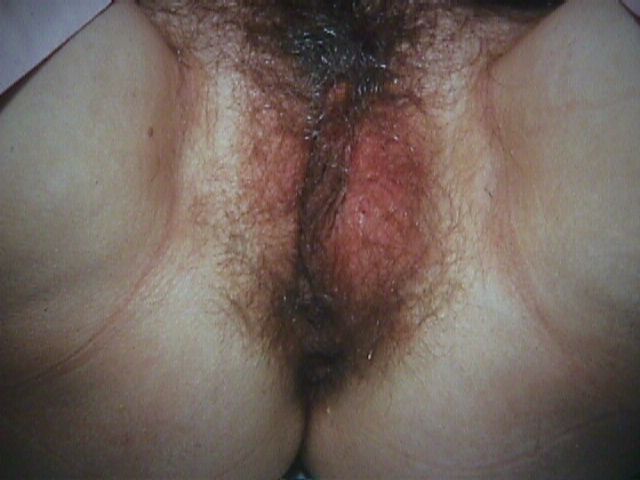|
Bartholin Cyst and Abscess |
 Bartholin Cyst
|
The Bartholin glands are located on each side of the vaginal opening at the level of the posterior fourchette. Normally, they are neither visible nor palpable. These glands produce small amounts of secretions that are not clinically significant. Their physiologic purpose is not known. Only when they become diseased do they become clinically apparent. The secretions produced by Bartholin glands pass through a somewhat convoluted duct structure before reaching the skin surface. If a duct becomes obstructed (from trauma, swelling, infection, etc.), the normal outflow of gland secretions is blocked. The secretions will then gradually build up beneath the skin surface, forming a Bartholin cyst. Bartholin cysts are noticed as painless swellings in the labia majora. The patient may or may not be aware of it (usually they are noticed). Bartholin cysts are not dangerous, have no malignant potential, and may be safely observed, if that is the pateint's desire. Alternatively, it is a relatively simple procedure to drain them. Many patients find them annoying enough to want them to go away. Should the Bartholin gland become infected, it will form a Bartholin abscess. In this case, the labia majora becomes excruciatingly painful, red and swollen. Some of these will drain spontaneously and this process may be hastened by warm moist dressings or sitz baths. Others will require drainage. Incision and Drainage of the abscess gives immediate relief. Watch a video for a demonstration of this procedure on a Bartholin cyst:
Simple incision and drainage of the abscess will provide immediate relief and more likely than not, permanent cure. In a significant minority of patients treated with simple I&D, the abscess or cyst will re-occur. This happens because after healing, the surgical opening into the cyst or abscess cavity seals over, resulting in isolation of the Bartholin gland beneath the skin. For this reason, more aggressive surgical treatment is sometimes used. Insertion of a "Word Catheter" helps keep the drainage tract open long enough for the cut skin edges to re-epithelialize to the inside of the cyst. Essentially, this results in a new duct connecting the Bartholin gland directly to the skin surface. Another way to accomplish the same thing is to "marsupialize" the cyst or abscess. After opening the cyst, suture the skin edge to the cyst wall. This allows the cut skin cell fibroblasts the opportunity to spread down into the cyst, with creation of a new opening to allow secretions to escape. Finally, complete excision of the Bartholin gland is an option when other, simpler procedures have been unsuccessful. Excision should result in permanent cure, but it technically challenging as the tissue planes may be scarred from old infection, bleeding may be surprisingly brisk, and healing more painful and protracted than you might think. In the end, good results are usually obtained. Bartholin gland cancer is an uncommon malignancy, comprising about 5% of all vulvar cancers. It is usually discovered after unsuccessful treatment for presumed Bartholin cyst or abscess. Treatment is radical vulvectomy and lymph node dissection. |


